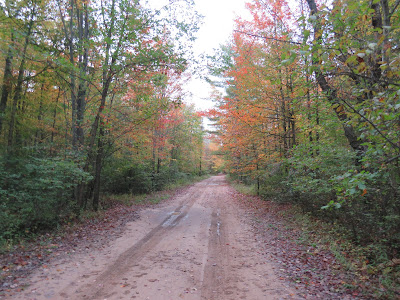On a mostly cloudy morning with temperatures in the low 60’s, Riley and I are following a dirt road north through a very rural, flat, wooded section of Isabella County where broadleaf trees are starting to lose their chlorophyll. Referred to by locals as the “End of the World” trail, this narrow lane appears to be a place for high schoolers to party and off-roaders to explore. My first sighting is a “black” squirrel scampering up a tree trunk. Despite its appearance, this is an Eastern Gray squirrel in disguise. The color variation is the result of a genetic mutation that causes excessive pigmentation. This phenomenon is called "melanistic," which refers to melanin, a chemical of pigmentation. Further along, I look overhead to see leaves of Red Oak turning colors and look down where newly-fallen Aspen and Maple leaves add a colorful layer to the drab leaf litter. Continuing north, I come upon a patch of fresh, very edible Oyster mushrooms and a female Winterberry shrub displaying bright red berries. Since this species is dioecious, to get berries on a female plant, a separate male plant must be near for pollination. The berries remain for several weeks through fall and winter, as birds tend not to be interested in them until they ripen. Though an important food source for wildlife, the berries are poisonous to pets and people. Nearby, the dainty blossoms of a Witch Hazel tree catch my attention. These late-blooming flowers are fragrant and add color to the increasing stark woodland. After walking about a half mile on this wet dirt road through prime deer habitat, I’m both surprised and puzzled not to see a single track. Turning around, we hike south on a parallel earthen trail covered with Wintergreen plants bearing fruit. These berries are a favorite breath mint and trailside snack. One of the few fruits that is at its sweetest and freshest on a cold winter or early spring day, frozen Wintergreen berries offer the texture of sorbet and a classic wintergreen flavor. Just before reaching the car, I spot a 4-inch Amanita mushroom. Also known as "fly agaric", it can attract and kill flies. Also, it appears to be attractive and lethal to dogs and cats, as well. To humans, this mushroom is not poisonous per se, but rather hallucinogenic. When eaten, one can become intoxicated or get sick and vomit.
An aura of autumn
Before snows come
From sunny glades
Colors and shades
Of scarlet and gold
Trees, young and old
Where frost of fall
Envelops it all
In crystalline white
During longer night
Mother Nature’s show
Her October glow
D. DeGraaf

A beautiful walk. Thank you.
ReplyDelete